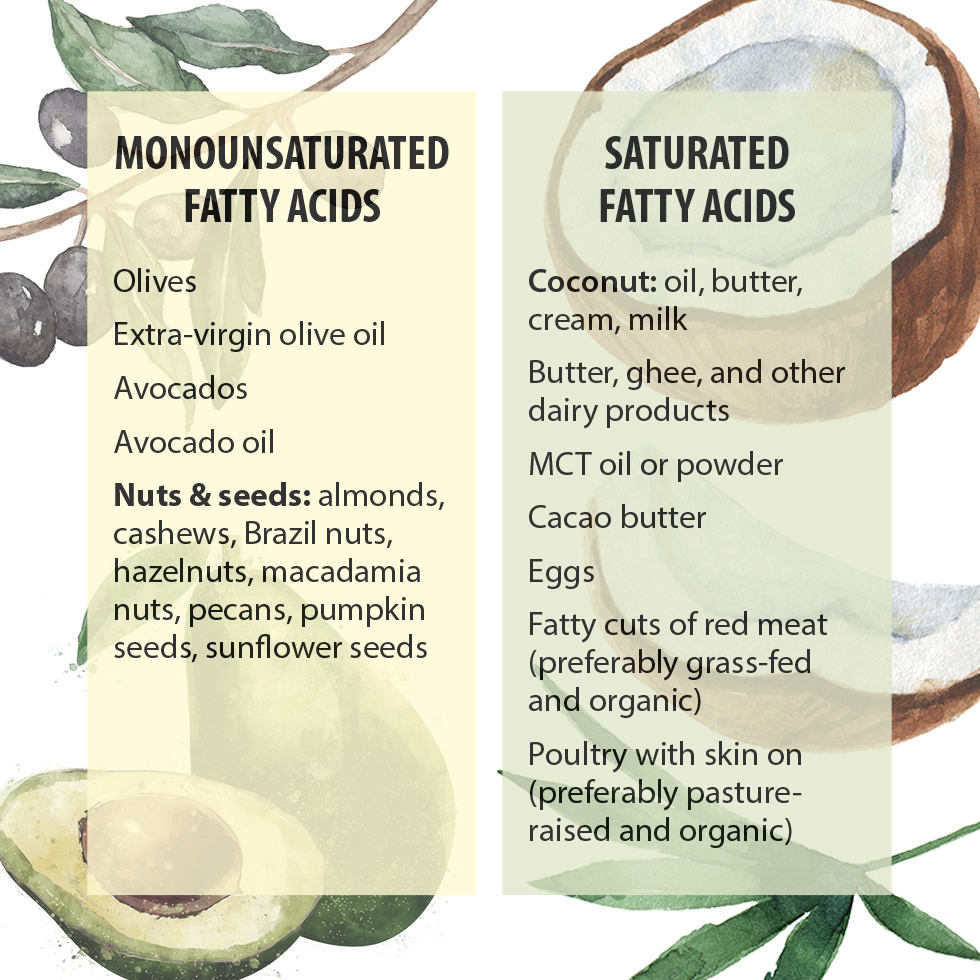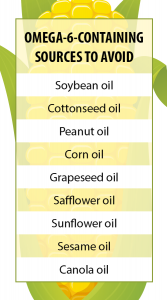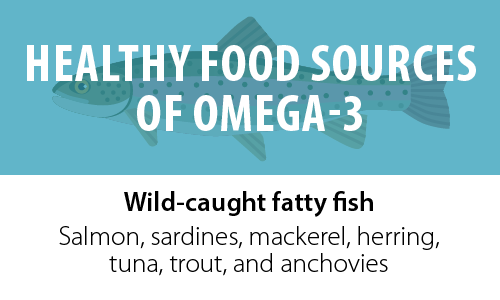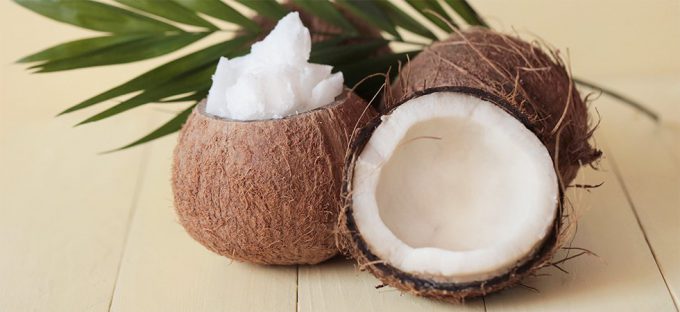Quality Fats on a Ketogenic Diet
By Kristi Storoschuk
There is a lot of hype around the ketogenic diet, and for good reason! Research is constantly emerging alluding to the benefits of the diet. However, just as with any diet, there are good and bad ways to approach it.
A ketogenic diet is a high-fat, moderate-protein, low-carbohydrate diet, and when done properly goes far beyond just limiting carbohydrates and increasing fat consumption. Since the majority of calories come from fat, it is crucial to know that the fat type and quality matter. The optimal approach to the ketogenic diet includes healthy, high-quality sources of fat that will fuel you rather than bring you down.
A Brief Overview on Fats:
There are three main categories of fatty acids that differ based on the length of their carbon backbone and number of hydrogen bonds:
- Saturated Fatty Acids (SFA): fully “saturated” with hydrogen atoms
- Monounsaturated Fatty Acids (MUFA): missing one pair of hydrogen atoms
- Polyunsaturated Fatty Acids (PUFA): missing two or more pairs of hydrogen atoms
So which are best for a ketogenic diet?
- Saturated Fatty Acids (SFA): YES
- Monounsaturated Fatty Acids (MUFA): YES
- Polyunsaturated Fatty Acids (PUFA): Sparingly
Saturated Fatty Acids and Monounsaturated Fatty Acids:
These are the ones you want to focus on and where the majority of your fats should be coming from. They are the body’s preferred source of energy when keto-adapted (the metabolic switch from burning glucose to burning fats and ketones). You might be thinking, isn’t all that saturated fat going to increase my risk for heart disease? Fret not; research is now pointing the finger at carbohydrates to blame for what saturated fats were accused of all these years.1

Note: Relying heavily on dairy as your source of fat may cause issues in certain individuals. Pay attention to the way you feel after consuming dairy and speak to your healthcare provider if you have concerns. Your healthcare provider may want to test blood lipids and other markers and make adjustments to your diet accordingly.
Polyunsaturated Fatty Acids (PUFA):
Polyunsaturated fatty acids only need to be consumed in small amounts but contain the two essential fatty acids (EFA), omega-6 and omega-3, that must be obtained through diet since humans cannot produce them on their own.
The Lowdown on Omega-6 PUFA:
 Although essential, omega-6 fatty acids are commonly overconsumed in the form of linoleic acid (LA) due to the increasing overuse of highly refined and processed vegetable/seed oils. Excess omega-6 might contribute to problems down the road, given that LA is the precursor to a number of highly inflammatory molecules, also known as pro-inflammatory eicosanoids.2 Recent research has linked chronic inflammation to a number of different health conditions, therefore consuming food with anti-inflammatory properties might be beneficial to your overall health. When following a ketogenic diet, you will likely get all the omega-6 you need without consciously trying, just by eating different nuts, seeds, healthy oils, meat and poultry, dairy products, and eggs. To avoid consuming excess amounts of omega-6 fatty acids, stay clear of the sources listed right.
Although essential, omega-6 fatty acids are commonly overconsumed in the form of linoleic acid (LA) due to the increasing overuse of highly refined and processed vegetable/seed oils. Excess omega-6 might contribute to problems down the road, given that LA is the precursor to a number of highly inflammatory molecules, also known as pro-inflammatory eicosanoids.2 Recent research has linked chronic inflammation to a number of different health conditions, therefore consuming food with anti-inflammatory properties might be beneficial to your overall health. When following a ketogenic diet, you will likely get all the omega-6 you need without consciously trying, just by eating different nuts, seeds, healthy oils, meat and poultry, dairy products, and eggs. To avoid consuming excess amounts of omega-6 fatty acids, stay clear of the sources listed right.
Whether you are avoiding omega-6 or not, these oils should probably be avoided for the following reasons: They are often made from GMO crops,3 are highly processed (i.e. exposed to various chemicals),4 are prone to oxidation creating potentially toxic byproducts,5 and can be partially hydrogenated.6 All things you may not want to hear about your food.
The Lowdown on Omega-3 PUFAs:
Omega-3 fatty acids are commonly underconsumed, creating a high omega-6-to-omega-3 ratio. It has been estimated that those following a typical Western Diet consumes a ratio as high as 20:1, extremely far from the ideal ratio of 1:1.7 There are two very important omega-3 fatty acids, eicosapentaenoic acid (EPA) and docosahexaenoic acid (DHA), which have been linked to support for neurological, immune, cardiovascular, and eye health, along with fetal development and so much more.8 Decreasing omega-6 consumption may even be equally as important as increasing omega-3s, since LA can inhibit the body’s ability to utilize EPA.9

Note: EPA and DHA originate from microalgae. Fish consume these microalgae and store the EPA and DHA in their body fat.
Without supplementation, those following a plant-based diet often struggle to consume enough EPA and DHA, since there is no other plant source other than microalgae. Any other plant food that contains omega-3 fatty acids, such as walnuts or flaxseeds, are in the form of alpha linoleic acid (ALA). ALA is the precursor to EPA and DHA, and while humans have the ability to convert ALA to EPA and DHA, the rate of doing so is extremely low, ~5-10% to EPA and ~2-5% to DHA.10 So don’t be fooled by plant-based foods advertised as a source of omega-3; the amount of ALA in these foods will likely not give you nearly enough EPA and DHA to meet recommendations. If you follow a plant-based diet, it is in your best interest to find an algal-sourced EPA/DHA supplement. For those who are not plant-based but do not consume fatty fish weekly, fish or krill oil supplements are great options too.
Tips on Using Healthy Oils and Fats:
- When choosing oils, opt for cold-pressed, unrefined, extra-virgin, and stored in glass (not plastic) when available
- Use oils with high saturated or monounsaturated fat content for cooking such as coconut oil, butter/ghee, avocado oil, and high quality extra-virgin olive oil since these are less likely to oxidize under heat
- Cook meats below 300° F to protect the integrity of their fatty acid profiles (and their amino acid profile too!)
- If you absolutely must use vegetable/seed oils do not cook with them due to their instability and likelihood of oxidation, especially under heat
References:
- DiNicolantonio J et al. The evidence for saturated fat and for sugar related to coronary heart disease. Prog Cardiovasc Dis. 2016;58(5):464-472.
- Calder P. Polyunsaturated fatty acids and inflammatory processes: New twist on old tale. Biochimie. 2009;91:791-795.
- Nakai S et al. Transportability of confined field trial data from cultivation to import countries for environmental risk assessment of genetically modified crops. Transgenic Res. 2015;24(6):929-944.
- Vegetable Oil Production: Industry Profile. Research Triangle Institute. https://www3.epa.gov/ttn/ecas/regdata/IPs/Vegetable%20Oil_IP.pdf. Accessed June 29, 2018.
- Vieira SA et al. Challenges of utilizing healthy fats in foods. Adv Nutr. 2015;6(3):309S-317S.
- https://articles.mercola.com/sites/articles/archive/2014/02/24/modern-diet.aspx. Accessed May 14, 2018.
- Patterson E et al. Health implications of high dietary omega-6 polyunsaturated fatty acids. J Nutr Metab. 2012;2012:539426..
- Swanson D et al. Omega-3 fatty acids EPA and DHA: health benefits throughout life. Adv Nutr. 2012;3(1):1-7.
- Cleland LG et al. Linoleate inhibits EPA incorporation from dietary fish-oil supplements in human subjects. Am J Clin Nutr. 2002;55(2):395-399.
- Davis BC et al. Achieving optimal essential fatty acid status in vegetarians: current knowledge and practical implications. Am J Clin Nutr. 2003;78(3 suppl):640S-646S.






